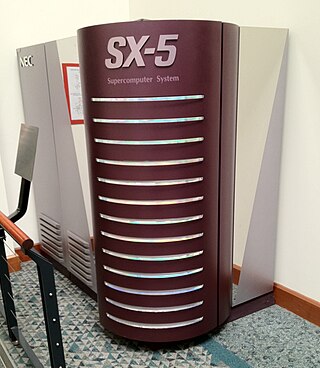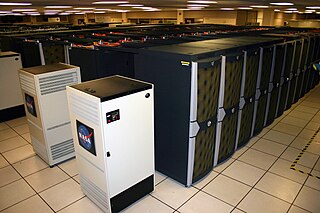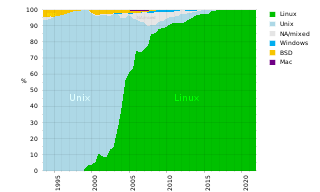
INK (for I/O Node Kernel) is the operating system that runs on the input output nodes of the IBM Blue Gene supercomputer. [1] [2] INK is a Linux derivative. [2]

INK (for I/O Node Kernel) is the operating system that runs on the input output nodes of the IBM Blue Gene supercomputer. [1] [2] INK is a Linux derivative. [2]

A supercomputer is a computer with a high level of performance as compared to a general-purpose computer. The performance of a supercomputer is commonly measured in floating-point operations per second (FLOPS) instead of million instructions per second (MIPS). Since 2017, supercomputers have existed which can perform over 1017 FLOPS (a hundred quadrillion FLOPS, 100 petaFLOPS or 100 PFLOPS). For comparison, a desktop computer has performance in the range of hundreds of gigaFLOPS (1011) to tens of teraFLOPS (1013). Since November 2017, all of the world's fastest 500 supercomputers run on Linux-based operating systems. Additional research is being conducted in the United States, the European Union, Taiwan, Japan, and China to build faster, more powerful and technologically superior exascale supercomputers.

A Beowulf cluster is a computer cluster of what are normally identical, commodity-grade computers networked into a small local area network with libraries and programs installed which allow processing to be shared among them. The result is a high-performance parallel computing cluster from inexpensive personal computer hardware.
MOSIX is a proprietary distributed operating system. Although early versions were based on older UNIX systems, since 1999 it focuses on Linux clusters and grids. In a MOSIX cluster/grid there is no need to modify or to link applications with any library, to copy files or login to remote nodes, or even to assign processes to different nodes – it is all done automatically, like in an SMP.
Kerrighed is an open source single-system image (SSI) cluster software project. The project started in October 1998 at the Paris research group The French National Institute for Research in Computer Science and Control. From 2006 to 2011, the project was mainly developed by Kerlabs. In January, 2012 the Linux clustering mission of Kerlabs was adopted by a new company: We Cluster, Inc. headquartered in Pacific Grove, California. January 18, 2012: Kerrighed 3.0 has been ported to Ubuntu 12.04 with Linux Kernel v3.2.

ASCI Red was the first computer built under the Accelerated Strategic Computing Initiative (ASCI), the supercomputing initiative of the United States government created to help the maintenance of the United States nuclear arsenal after the 1992 moratorium on nuclear testing.
SUPER-UX was a version of the Unix operating system from NEC that is used on its SX series of supercomputers.

NEC SX describes a series of vector supercomputers designed, manufactured, and marketed by NEC. This computer series is notable for providing the first computer to exceed 1 gigaflop, as well as the fastest supercomputer in the world between 1992–1993, and 2002–2004. The current model, as of 2018, is the SX-Aurora TSUBASA.

Özalp Babaoğlu, is a Turkish computer scientist. He is currently professor of computer science at the University of Bologna, Italy. He received a Ph.D. in 1981 from the University of California at Berkeley. He is the recipient of 1982 Sakrison Memorial Award, 1989 UNIX InternationalRecognition Award and 1993 USENIX AssociationLifetime Achievement Award for his contributions to the UNIX system community and to Open Industry Standards. Before moving to Bologna in 1988, Babaoğlu was an associate professor in the Department of Computer Science at Cornell University. He has participated in several European research projects in distributed computing and complex systems. Babaoğlu is an ACM Fellow and has served as a resident fellow of the Institute of Advanced Studies at the University of Bologna and on the editorial boards for ACM Transactions on Computer Systems, ACM Transactions on Autonomous and Adaptive Systems and Springer-Verlag Distributed Computing.
Xgrid is a proprietary grid computing program and protocol developed by the Advanced Computation Group subdivision of Apple Inc.

A computer cluster is a set of computers that work together so that they can be viewed as a single system. Unlike grid computers, computer clusters have each node set to perform the same task, controlled and scheduled by software. The newest manifestation of cluster computing is cloud computing.
Locus Computing Corporation was formed in 1982 by Gerald J. Popek, Charles S. Kline and Gregory I. Thiel to commercialize the technologies developed for the LOCUS distributed operating system at UCLA. Locus was notable for commercializing single-system image software and producing the Merge package which allowed the use of DOS and Windows 3.1 software on Unix systems.
In computing, algorithmic skeletons, or parallelism patterns, are a high-level parallel programming model for parallel and distributed computing.
A lightweight kernel (LWK) operating system is one used in a large computer with many processor cores, termed a parallel computer.

The Slurm Workload Manager, formerly known as Simple Linux Utility for Resource Management (SLURM), or simply Slurm, is a free and open-source job scheduler for Linux and Unix-like kernels, used by many of the world's supercomputers and computer clusters.

OpenComRTOS is a commercial network-centric, formally developed real-time operating system (RTOS), aimed mainly at the embedded system market.

Quasi-opportunistic supercomputing is a computational paradigm for supercomputing on a large number of geographically disperse computers. Quasi-opportunistic supercomputing aims to provide a higher quality of service than opportunistic resource sharing.

Approaches to supercomputer architecture have taken dramatic turns since the earliest systems were introduced in the 1960s. Early supercomputer architectures pioneered by Seymour Cray relied on compact innovative designs and local parallelism to achieve superior computational peak performance. However, in time the demand for increased computational power ushered in the age of massively parallel systems.

Compute Node Kernel (CNK) is the node level operating system for the IBM Blue Gene series of supercomputers.

A supercomputer operating system is an operating system intended for supercomputers. Since the end of the 20th century, supercomputer operating systems have undergone major transformations, as fundamental changes have occurred in supercomputer architecture. While early operating systems were custom tailored to each supercomputer to gain speed, the trend has been moving away from in-house operating systems and toward some form of Linux, with it running all the supercomputers on the TOP500 list in November 2017. In 2021, top 10 computers run for instance Red Hat Enterprise Linux (RHEL), or some variant of it or other Linux distribution e.g. Ubuntu.

MCST is a Russian microprocessor company that was set up in 1992. Different types of processors made by MCST were used in personal computers, servers and computing systems. MCST develops microprocessors based on two different instruction set architecture (ISA): Elbrus and SPARC. MCST is a direct descendant of the Lebedev Institute of Precision Mechanics and Computer Engineering.